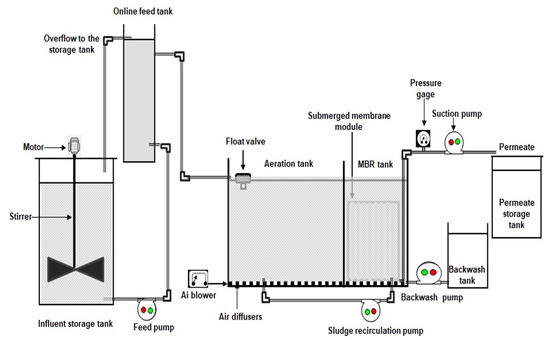Troubleshooting Common Issues with Membrane Bioreactor Systems
The Benefits of Membrane Bioreactors in Sustainable Wastewater Administration
Membrane bioreactors (MBRs) stand for an essential innovation in lasting wastewater administration, successfully merging organic therapy with advanced membrane layer filtration technology. As the demand for lasting options magnifies, discovering the multifaceted advantages of MBRs might expose unexpected effects for the future of wastewater treatment systems.
Review of Membrane Layer Bioreactors
Membrane layer bioreactors (MBRs) represent a significant improvement in wastewater treatment modern technology, incorporating organic degradation with membrane filtration to enhance the efficiency of the therapy procedure. This cutting-edge system combines the advantages of conventional activated sludge procedures with membrane modern technology, permitting enhanced solid-liquid splitting up. MBRs make use of semi-permeable membranes to different cured water from biomass, causing premium effluent that can be recycled or securely released right into the atmosphere.
The functional style of MBRs commonly entails a bioreactor where bacteria break down organic issue, followed by a membrane layer unit that filterings system the mixed liquor. This configuration not only decreases the impact of the treatment center but likewise allows for higher biomass concentrations and minimized hydraulic retention times. In addition, MBRs can treating a broader variety of contaminants, consisting of virus and nutrients, making them suitable for various applications, from municipal wastewater therapy to industrial effluent handling.
The combination of MBRs right into wastewater management systems is a sign of an expanding trend towards reliable and lasting methods in environmental design. Their ability to generate premium effluent while reducing room demands positions MBR innovation as a principal in modern wastewater therapy solutions.
Improved Effluent Top Quality

The membrane layer filtering process acts as a physical barrier, enabling the retention of microorganisms and particulate matter, which contributes to a clearer and cleaner effluent (Membrane Bioreactor). Furthermore, MBRs operate at higher biomass concentrations than traditional turned on sludge systems, promoting extra effective biodegradation of toxins. This results in a reduction in biochemical oxygen demand (BOD) and overall put on hold solids (TSS) levels in the last effluent
Furthermore, MBRs show exceptional performance in treating difficult wastewater structures, such as industrial effluents and wastewater with high nutrient loads. Consequently, the effluent produced is frequently of better, permitting more adaptable disposal alternatives and minimized environmental effect. Inevitably, the boosted effluent top quality attained with MBR modern technology underscores its important function in progressing sustainable wastewater administration techniques.
Water Reuse Opportunities
The top quality effluent created by membrane layer bioreactors (MBRs) opens up significant chances for water reuse in numerous applications. MBRs successfully remove contaminants, including microorganisms, put on hold solids, and natural issue, resulting in treated water that satisfies or surpasses regulative standards for reuse. This high quality permits for the execution of water recycling initiatives throughout varied sectors.
One popular application is in agriculture, where treated wastewater can be utilized for irrigation, promoting sustainable farming methods while saving fresh water resources. Additionally, MBR-treated effluent can be used for industrial processes such as cooling, cleansing, and as a procedure water resource, dramatically lowering the need for potable water in these operations.
In metropolitan atmospheres, MBRs help with using reclaimed water for landscape watering, toilet flushing, and various other non-potable usages, adding to the overall resilience of supply of water systems. The combination of MBR technology in decentralized systems help in taking care of localized water demands, specifically in water-scarce regions.
Decreased Environmental Influence
How can the fostering of membrane bioreactors (MBRs) add to a decreased ecological impact in wastewater monitoring? MBRs substantially boost the treatment performance of wastewater while reducing ecological disturbances. Membrane Bioreactor.
Furthermore, MBRs operate at reduced hydraulic retention times contrasted to conventional systems, causing smaller therapy plant impacts. This compact style lowers helpful hints land use, therefore preserving all-natural environments and biodiversity. The procedure also creates less sludge than standard approaches, minimizing disposal obstacles and reducing greenhouse gas discharges linked with sludge management.
Furthermore, MBRs promote the recovery of valuable resources, such as water and nutrients, adding to a circular economic situation. By enabling water reuse for watering or commercial procedures, MBRs help relieve freshwater deficiency, hence advertising lasting water utilize techniques. Inevitably, the adoption of MBR modern technology stands for a significant stride in the direction of minimizing the environmental impact of wastewater administration systems.
Economic Benefits of MBRs

Additionally, MBRs help with the production of high-quality effluent, which can be reused for numerous applications, such as agricultural irrigation and industrial procedures - Membrane Bioreactor. This reuse capacity can substantially reduce water purchase prices, giving a financial motivation for markets encountering strict water laws
The small design of MBR systems also causes minimized land needs, which is particularly beneficial in city areas where property is pricey. By decreasing room, industries and municipalities can save money on land purchase and maintenance expenses.
Additionally, MBRs typically require much less regular maintenance and have a longer life-span than typical systems, even more contributing to set you back savings. In recap, the economic advantages of MBRs-- varying from reduced functional expenses to land financial savings and effluent reuse-- make them a compelling choice for sustainable wastewater monitoring, offering both long-lasting and prompt financial advantages.
Conclusion
Additionally, MBRs add to lowered ecological impacts through compact layouts and reduced sludge generation. Economic benefits additionally improve their stability, making MBRs an encouraging remedy for resolving the obstacles of wastewater therapy and advertising lasting source administration.
Membrane bioreactors (MBRs) represent a pivotal improvement in lasting wastewater administration, efficiently merging organic therapy with advanced membrane filtration technology.Membrane layer bioreactors (MBRs) stand for a considerable development in wastewater treatment technology, incorporating organic degradation with membrane purification to improve the efficiency of the therapy procedure.Attaining enhanced effluent high quality is one of the most substantial advantages of using membrane layer bioreactors (MBRs) in wastewater therapy.In addition, MBRs show outstanding efficiency in treating challenging wastewater make-ups, such as industrial effluents and wastewater with high nutrient loads.Incorporating membrane bioreactors (MBRs) right into wastewater administration not just lowers ecological impact yet likewise offers considerable financial page advantages.